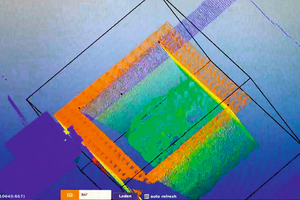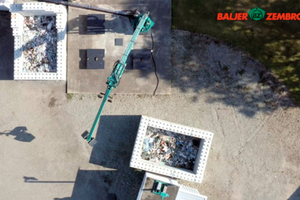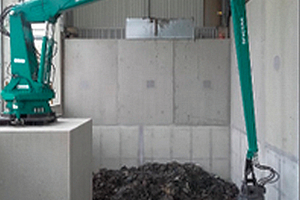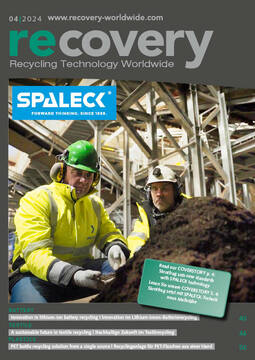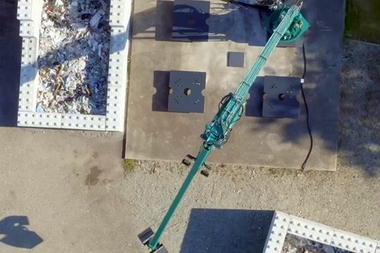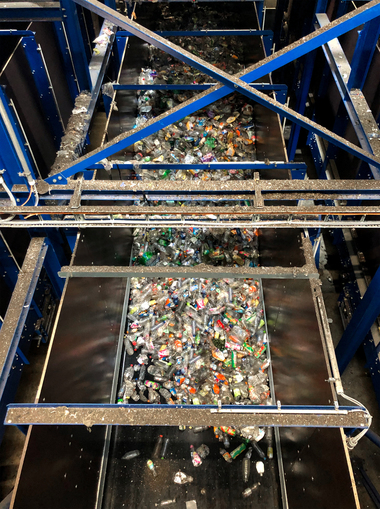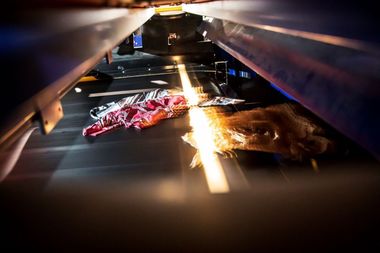Electro-hydraulically driven stationary crane
Baljer & Zembrod has developed the fully automatic handling of homogeneous material (example in recycling: “yellow bag“) on the basis of an electro-hydraulically driven stationary crane. In the first stage, the aim was to enable the crane to move the material independently (at the “push of a button“) from a specific point, such as a waste bunker, to a target point, for example a hopper, and back to the starting point, as an assistance system for the crane operator.
This objective is realized with two stationary cranes that were delivered to the company Sarpi (Veolia) and are currently being put into operation at the Marl site in Germany. In the second expansion stage, the hydraulic crane is fully automated so that it can work independently, i.e. unmanned. Sensors installed on the crane determine the position of the crane in the room at all times. An externally positioned scanner scans the “material pile“ and provides the data for the control system to position the gripper at the desired location; the “material peak“ of the material pile (see photo “Material scan“). After gripping the material, the crane moves the material to a desired unloading point and releases the material from the gripper. This fully automated process was implemented in a demonstration system on our factory premises in 88361 Altshausen with an OBX-V stationary crane (arm length 13 m, lifting force 2.8 t at 13 m) and two bunkers (see photo “Demonstration system“).
The handling is not automated by precise stepper motors (as is usual with robots), but the crane is controlled by a standard hydraulic system. Standard robots on the market are not suitable for this application for various reasons:
Reaches, i.e. crane arm lengths of up to 20 m must be achieved, with a lifting capacity of up to 6 t at maximum outreach. Classic robots would be far too expensive to purchase here
The environment on site is very dirty (dust, condensation, wet waste) and not suitable for conventional robot technology
The challenges lay firstly in programming the crane using a standard Siemens controller (TIA Portal) and secondly in making the necessary adjustments to the hydraulic system. The system was able to achieve an accuracy of ± 5 cm on the gripper, regardless of the outside and oil temperature. A movie about the demonstration system is available at www.smartrecycling-projekt.de.
Partner in the funded research project “Smart Recycling“
The approach of the current research project “Smart Recycling“ (www.smartrecycling-projekt.de) for the automated sorting of large, valuable plastic waste, metals, wood, etc. with the help of AI ideally complements our fully automated crane. Participants include the DFKI (German Research Center for Artificial Intelligence), Hamburg University of Applied Sciences and Bremen University of Applied Sciences.
Added value of the assistance system (first expansion stage)
Increasingly, recycling waste may no longer be handled outdoors, but in halls. Due to the nature of the system, some of these enclosures are very narrow, meaning that the crane operator always runs the risk of damaging the walls or equipment with the grab. The risk is all the greater if the material is hazardous (flammable, explosive) and can easily ignite if sparks are generated (grapple touches a concrete wall). Another risk factor is when the operator no longer has to control the crane from a cabin on the crane, but from a remote control station via screens, i.e. “remotely“.
Added value of full automation (second expansion stage)
Unmanned handling of recycling material, for example to feed a waste sorting system, naturally has the advantage for the recycling company that 3 to 4 operators can be saved in 2 – 3 shift operation. In addition, this type of work, handling waste with a stationary crane, is very monotonous and therefore unpopular. There are currently major problems filling such positions at all. Automated handling has the advantage that human factors (carelessness, fatigue, etc.) on the part of the crane operator can be ruled out.

